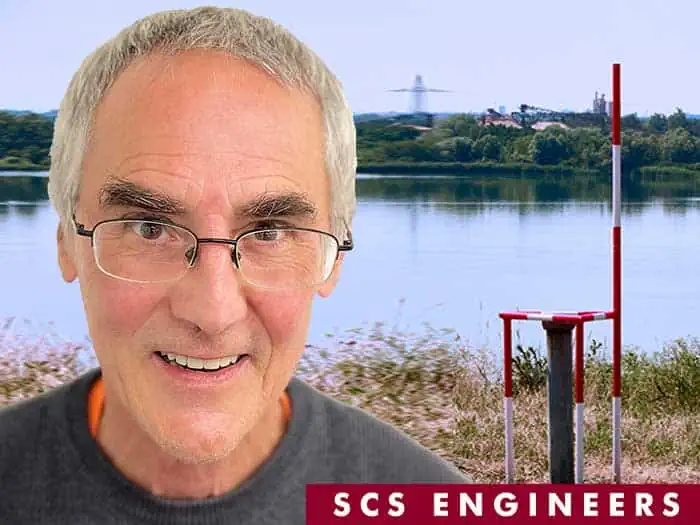


Meet Charles Hostetler, of SCS Engineers, at Session 4B Soil and Groundwater Characterization and Conceptualization on Tuesday, April 18, 3:30-5:50 for a discussion of CCR detection monitoring to minimize false positives.
CCR groundwater monitoring programs require routine detection monitoring around regulated units. Routine detection monitoring aims to identify situations where groundwater quality could be impacted by contaminants mobilized from CCR. Background data are collected to characterize the statistical distributions of groundwater quality parameters in the aquifer where there is no potential impact from regulated units. During operational, closure, and post-closure care activities, the same groundwater quality parameters are sampled periodically downgradient from the regulated unit and compared to these background data. Any statistically significant increases over background data spur an investigation of the potential result of CCR leachate impacting groundwater quality.
The procedure for designing and implementing a groundwater monitoring plan foresees that all routine detection monitoring programs will generate false positive results. The EPA’s Unified Guidance recommends that the design of monitoring plans minimize the site-wide false positive rate. For CCR detection monitoring programs, site-specific and regulatory requirements fix the number of well/parameter pairs and sampling frequencies, leaving the CCR permittee with two focus areas to minimize the site-wide false positive rate. The first is a robust background characterization that captures the site’s spatial and temporal variability. The second is a complete characterization of leachate composition, including unregulated constituents, and incorporating correlation into the statistical comparison to the background. These two focus areas can minimize costly assessment and corrective action activities.
Learn more about USWAG here. Register for USWAG here.
Additional Information located on CCR and Utilities is on the SCS website.
The USWAG Utility Decommissioning Workshop in Crystal City, VA, begins on December 12th. This valuable workshop provides utilities the chance to focus on topics that can save time and money while working toward new goals. We’ll be covering these topics:
SCS Engineers Vice President and Deep Well Injection Expert, Monte Markley, will present a session on how deep well injection is facilitating site development and minimizing post closure costs for utilities nationwide. The challange for sustainably managing CCR leachate and other liquid residuals as a facility is decommissioned is met in phases by facilitating site redevelopment allowing leachate lagoon or evaporation basins to be decommissioned in the short term and utilizing the DIW for long term leachate disposal. The small foot print of a deep injection well and the ability to safely, continuously operate with minimal staffing allows conventional leachate management infrastructure real estate to be re-purposed. Having the ability to decommission leachate lagoons and other water treatment infrastructure (e.g. groundwater pump and treat systems) within 18-24 months after closure allows owners to avoid significant post closure care costs. Avoided costs include long term operrations and maintenance, regulatory reporting, and financial assurance. Mr. Markley’s presentation based on case studies outlines the requirements to get a well permitted and operational at a facility, and includes examples of capital and opex costs avoided.
Navigating the Permitting Process for CCR Impoundment Closures and Groundwater Monitoring Systems
Join us on Monday, July 27 from noon to 2 p.m. CDT to learn how SCS Engineers helps electric utilities overcome permitting obstacles at CCR impoundments and landfills. We offer the service nationwide.
Using case studies, we’ll highlight the permitting process and the keys to how electric utilities overcame obstacles to achieve the results they needed.
What you can expect to learn?
Registration and USWAG conference information here. This year’s event is a series of webinars USWAG is offering at no additional charge for members and affiliates.
At the upcoming USWAG CCR Workshop Feb 22-23 in Arlington, VA, Steve Lamb and Floyd Cotter of SCS Engineers will present a session about the advantages and disadvantages of emerging alternative capping options, and how different regulatory agencies are viewing these options.
About this Session: Traditional final cover and capping design for coal combustion residual (CCR) surface impoundments and landfills have included compacted soil liner, geomembrane liner, drainage layer, and a vegetative soil cover. But coal-fired plants oftentimes don’t have the large volumes of soil that it takes to implement these options.
Alternative capping options have recently emerged in the industry such as exposed geomembrane liners or synthetic turf/geomembrane liner systems. Some of these alternative capping options have many advantages over their traditional counterparts. These advantages include faster installation times, minimal need for soil, improved storm water quality, and reduced maintenance and post-closure costs. For surface impoundments, alternative capping designs can also greatly reduce the amount of disturbance of the existing CCR material within the impoundment.
About Steve Lamb: Steve Lamb, PE provides SCS with over 27 years of experience in solid and hazardous waste management, environmental engineering, civil engineering, hydrology and hydraulics, landfill engineering, remedial design, and regulatory compliance. Mr. Lamb is a Vice President and director of SCS’s Charlotte, NC office.
About Floyd Cotter: Floyd Cotter specializes in solid waste management projects. His project work involves all areas of solid waste management including planning, permitting, transportation, landfill design, construction, and monitoring. Mr. Cotter is also experienced in general civil engineering, construction oversight, environmental site assessments, closure and post-closure plans, and permit and contract document preparation.